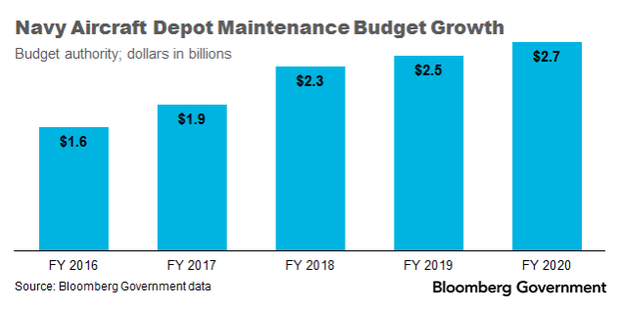Navy Aircraft Maintenance FY 2020 Budget Could Boost Contracting
Aircraft readiness is a high priority for the U.S. Navy, and it has budgeted $8.2 billion for maintenance to increase aircraft availability since 2016. The service’s $2.7 billion aircraft maintenance request for fiscal 2020 would be 7.5 percent larger than in fiscal 2019 and represents a 70 percent increase since 2016.

Readiness Goals
Last October, then-Defense Secretary James Mattis ordered both the Navy and the Air Force to get at least 80 percent of four fighter jet fleets (including the Navy’s F-18 and F-35) to a “mission capable” condition by the end of fiscal 2019. Both services accelerated their efforts to finish digging out of the hole that was created after the fiscal 2013 sequester, when maintenance was deferred to save money.
The Navy is also exploring high-tech approaches to improve readiness, speed the transition to new technology, and improve the integration and interoperability of fielded systems. In fiscal 2020, the Navy expects to achieve 95 percent of the maintenance requirements for the active component and 97 percent of the requirements for aircraft assigned to reserve units. For active units, that’s the best percentage in the past five years.
Dividing the Work
The nearly $2.7 billion budget request (including Overseas Contingency Operations dollars) would fund both in-house maintenance and contractor work. The two big buckets within the budget are aircraft depot maintenance and aviation logistics — the purchase of contractor support as a long-term integrated package designed to optimize system readiness and meet performance goals.
The Navy says that with the requested funding, its fleet readiness centers will be able to operate at maximum levels. It plans to increase work on engines and spend less on airframe maintenance in 2020.
Big Business
Total prime contract obligations for aircraft maintenance from fiscal 2016 through 2018 were $5.7 billion. In January, the Navy awarded 19 companies slots on a $12.6 billion multiple-award contract for aircraft maintenance services and contractor logistics services. Top contractors in fiscal 2018 include L-3 Communications Vertex Aerospace LLC, DynCorp International Inc., and Northrop Grumman Corp., according to the BGOV Contracts Intelligence Tool.

What’s Ahead
In its 2020 budget request, the Trump administration has proposed keeping both the defense and nondefense spending caps set by the Budget Control Act of 2011 at current levels and using the OCO budget (which is exempt from the caps) on base activities to get around the defense limits. House Armed Services Chairman Adam Smith (D-Wash) is skeptical of that approach. The 2020 budget includes $174 billion for Overseas Contingency Operations (war) and other emergency spending — far more than current contingency requirements justify. About $1.5 billion of that total is for Navy aircraft maintenance.
While the final fiscal 2020 budget won’t likely be settled until late this fall, aircraft readiness rates will continue to be a priority. That means that whatever deal is cut on the caps and OCO, Navy aircraft readiness is likely to get a budget boost, and that’s good news for contractors.
To contact the analyst: Cameron Leuthy in Washington, D.C. at cleuthy@bgov.com
To contact the editors responsible for this story: Daniel Snyder at dsnyder@bgov.com; Jodie Morris at jmorris@bgov.com